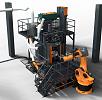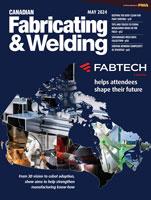- FMA
- The Fabricator
- FABTECH
- Canadian Metalworking
Breaking in your band saw blade
Breaking in a blade is one way to expand tool life
- January 3, 2023
- Article
- Fabricating
In the January 2023 issue of Canadian Fabricating & Welding, we outlined seven ways that fabricators can get the most out of their band saw. One of the ways to do that is to properly break in the blade.
Jay Gordon, North American sales manager, saws and hand tools at The L.S. Starrett Co. explains why and how to break in the blade.
Why Is Blade Break-in Necessary?
In the context of band saw cutting operations, high efficiency and productivity means keeping the saw running, and fabricators are always looking for ways to reduce downtime and extend blade life.
While cost is important, it is the cost per cut that really matters. Extending the life of a blade enables you make more high-quality cuts, increasing the saw’s productivity of the saw, which minimizes the cost per cut.
Blade design plays an important role and choosing the right blade for the application is essential. However, machine maintenance and operating practices can affect the blade’s surface life and the quality of the surface finish.
Following good operating and maintenance practices is important, and one critical step that is all too often skipped is breaking in the blade.
A properly broken-in blade will have a significantly increased tool life. So why skip over this important step?
Some operators feel that breaking in a blade slows down production which is in direct opposition to a shop’s goal of maximizing machine production time. However, the short amount of time that it takes to break in a blade can both increase productivity and cut quality. While it may not seem worth it upfront; it certainly is in the long run.
How to Break in a Blade
The band saw blade break-in process varies depending on the characteristics of the material being cut. Here are some general steps to follow:
- Start with the band saw running at the normal surface feet per minute (SFPM) based on the material being cut.
- Reduce the feed pressure on the saw to achieve a cutting rate approximately 25 to 50 per cent of the normal cutting rate.
- Gradually increase the cutting rate back to 100 per cent.
Pro Tip: As you increase the SFPM, make sure that there are no vibrations, which can reduce cut quality and cause premature blade wear. Slight adjustments to the band speed may need to be made in the event of excess noise and vibration.
While this is a general guide, there are some material-specific instructions to follow.
When working with softer materials like carbon steel and aluminum:
- Adjust the feed pressure to 50 per cent of the normal cutting rate for the first 50 to 100 sq. in.
- Gradually increase the feed pressure to 100 per cent cutting rate.
When working with harder materials like INCONEL, hardened steels, tool steels, and stainless steels:
- Adjust the feed pressure to 75 per cent of the normal cutting rate for 25 to 75 sq. in.
- Gradually increase the cutting rate to reach 100 per cent after 50 sq. in.
What Does Blade Break-in Actually Do?
New band saw blades have very sharp edges on the teeth that are prone to chipping and breaking. By gradually increasing the feed pressure during break-in, the sharp tooth edge is evenly honed, creating a very fine radius to the leading edge of the tooth.
Once the teeth are honed and properly broken in, the blade will cut faster, straighter, and last longer than a blade that has not been broken in.
Following a proper break-in process is a simple, easy way to ensure that you’re getting the maximum productivity in your sawing operation.
Jay Gordon is North American sales manager, saws and hand tools at The L.S. Starrett Co., 121 Crescent St., Athol, MA 01331, www.starrett.com.
subscribe now


Keep up to date with the latest news, events, and technology for all things metal from our pair of monthly magazines written specifically for Canadian manufacturers!
Start Your Free Subscription- Trending Articles
FMA Annual Meeting: Ingenuity still key with tech innovations

Messer Canada hosts anniversary event

Welding jacket designed for protection, comfort

Compact swing chamber shot blast machine features robotic workpiece handling

Gang punching press system accommodates different parts quickly

- Industry Events
MME Saskatoon
- May 28, 2024
- Saskatoon, SK Canada
CME's Health & Safety Symposium for Manufacturers
- May 29, 2024
- Mississauga, ON Canada
DiPaolo Machine Tools Open House 2024
- June 4 - 5, 2024
- Mississauga, ON Canada
FABTECH Canada
- June 11 - 13, 2024
- Toronto, ON Canada
Zoller Open House & Technology Days 2024
- June 12 - 13, 2024
- Ann Arbor, MI


















